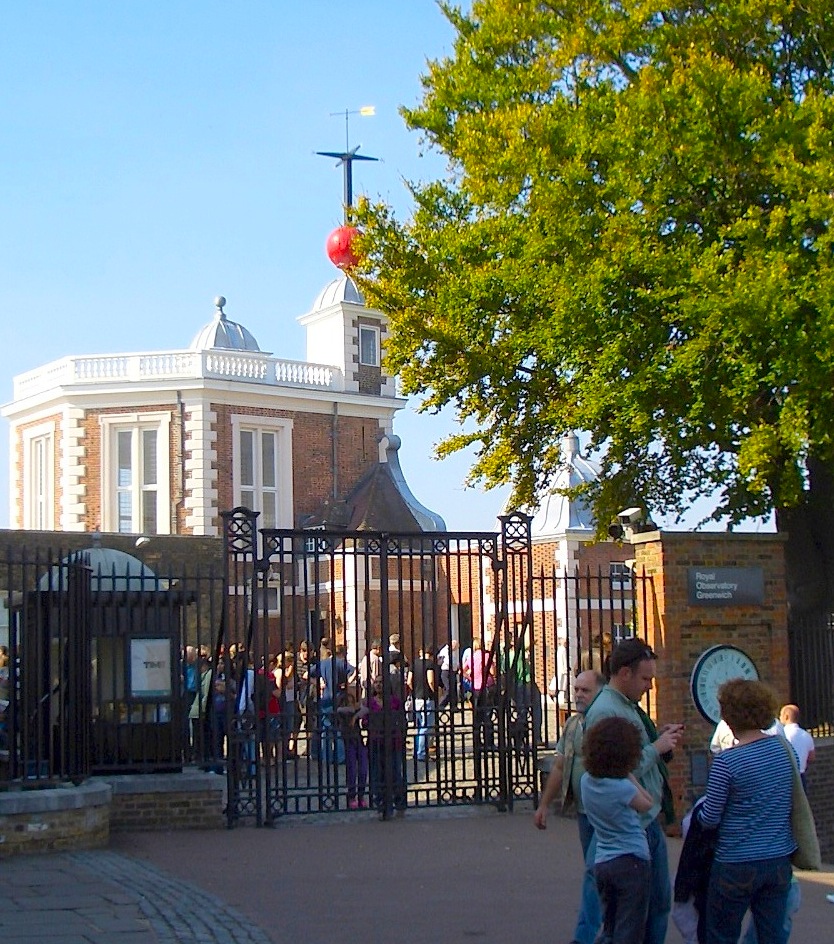
Greenwich Observatory. Photograph by Jacqueline Banerjee. Click on image to enlarge it.
When I first read Secret Agent as an undergraduate quite a bit more than a half century ago, I didn’t understand why Conrad’s First Secretary of a Foreign Power chose the Greenwich Observatory as a target other than perhaps he didn’t like science. It's never to late to learn, and when reading Peter Galison’s book-length study of the technological contexts of Einstein’s theory of relativity, the political and symbolical importance of Greenwich became clear.
Galison’s Einstein’s Clocks explains the role of synchronized clocks in creating accurate maps, and such “mapping offered both symbolic and practical mastery over space. In the great land grab of the mid-nineteenth century, fixing positions was critical for trade, for military conquest, for laying railroads” (132). Synchronizing clocks great distances apart, say, in England or France and North America required submarine cables that permitted telegraphers on opposite sites of the Atlantic Ocean to communicate. Great Britain, as it turned out, proved to be the master of such technology, inventing, manufacturing, laying, and controlling access to transatlantic and other long-distance submarine cables. After much opposition from France, a place in England — Greenwich Observatory — was chosen as the fixed point from which all time and distance would be measured, and “Without a doubt the first meridian stood as a powerful if highly contested symbol” (160). The Greenwich Observatory and Greenwich Mean Time stood at the center of empire, and as such it was an obvious and very rational symbolic target for anarchists to choose.
Perhaps the best known action against Greenwich is also one of the murkiest. On Thursday 15 February 1894, a young French anarchist, Martial Bourdin, bought a ticket from Westminster Bridge to Greenwich. According to one of two observatory assistants, when chatting in the lower computing room, the pair “were suddenly startled by a loud explosion, the detonation of which was sharp and clear. ... I immediately remarked to Mr. Hollis, ‘That is dynamite! Spot the time’.” Trained to observe by the clock, they duly recorded the detonation at 4:51. When a policeman arrived at the detonation scene in the park below the observatory, he found Bourdin dying. [160]
Long afterwards people argued over Bourdin’s motives: “anarchists suspected a police setup; others saw in it one more in the long series of French anarchist strikes, including one on the Chamber of Deputies in Paris (December 1893) and another in a Paris cafe just three days before Bourdin’s demise.” As Galison points out,
Conrad’s version of the events in his 1907 work The Secret Agent remains the canvas on which these events have been seen: a dark sketch of dupes, manipulators, and careerists from which no one emerges unsullied. In Conrad’s world the conniving First Secretary of a Foreign Power insisted on an attack that would frighten the class enemies beyond murder: “The demonstration must be against learning—science. The attack must have all the shocking senselessness of gratuitous blasphemy.” It must strike at the mysterious scientific heart of material prosperity. ‘“Yes,’ he continued with a contemptuous smile. ‘The blowing up of the first meridian is bound to raise a howl of execration.’”
Despite what the First Secretary of a Foreign Power has to say, Greenwich functioned, and was understood by many to function, as far more than just the “mysterious scientific heart of material prosperity,” though it was certainly that, too. The question remains, then, to what extent did Conrad see Greenwich Observatory as a perfect target for those against the then-current world order?
Bibliography
Galison, Peter. Einstein’s Clocks, Poincaré’s Maps: Empires of Time. New York: W. W. Norton: 2003.
Last modified 5 December 2017